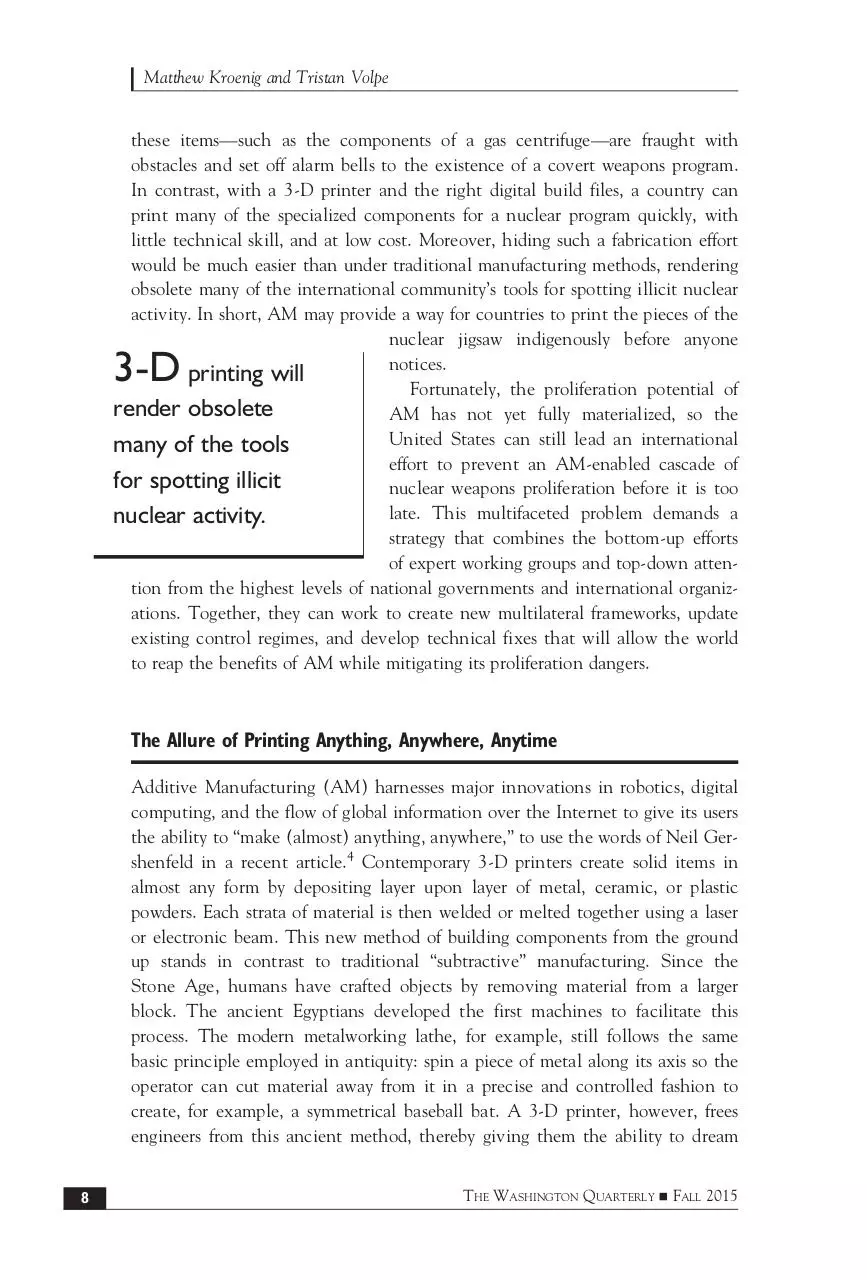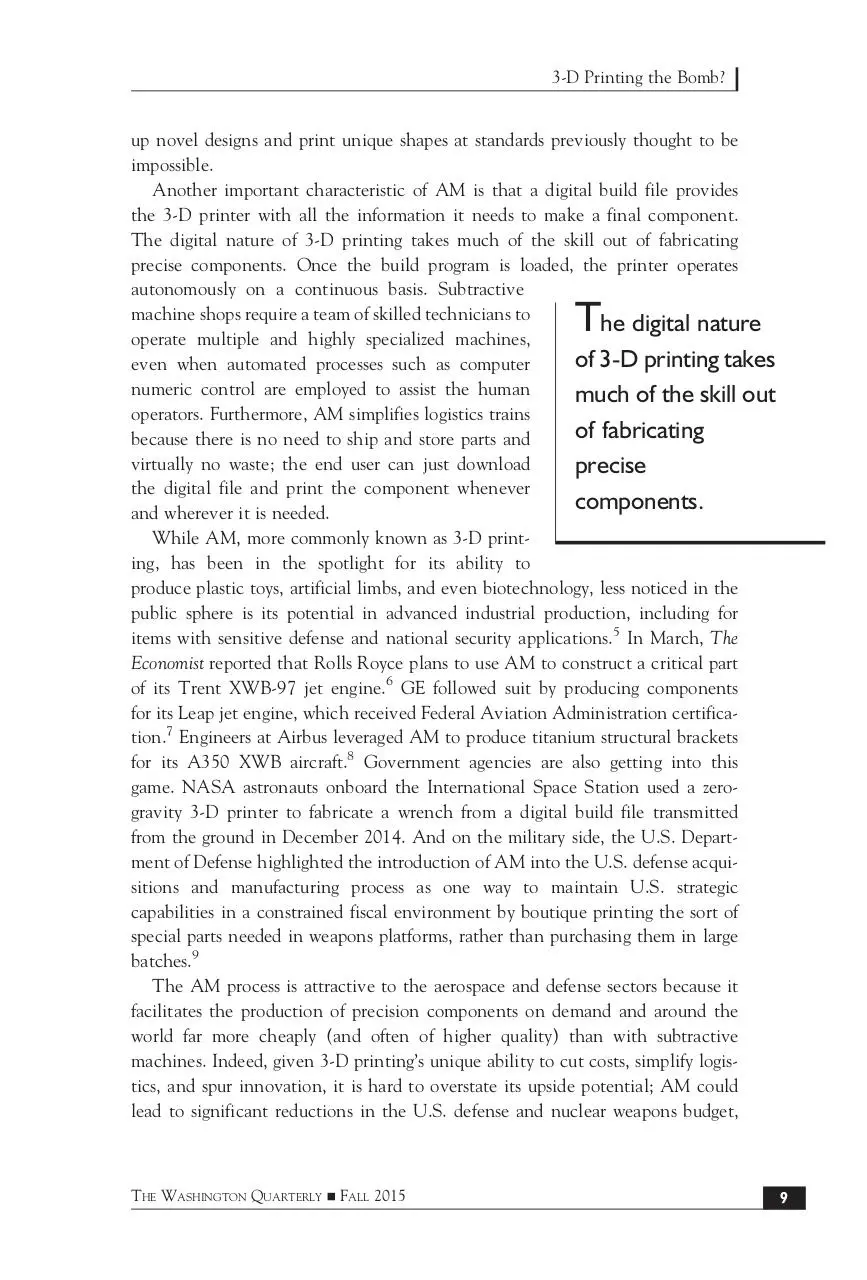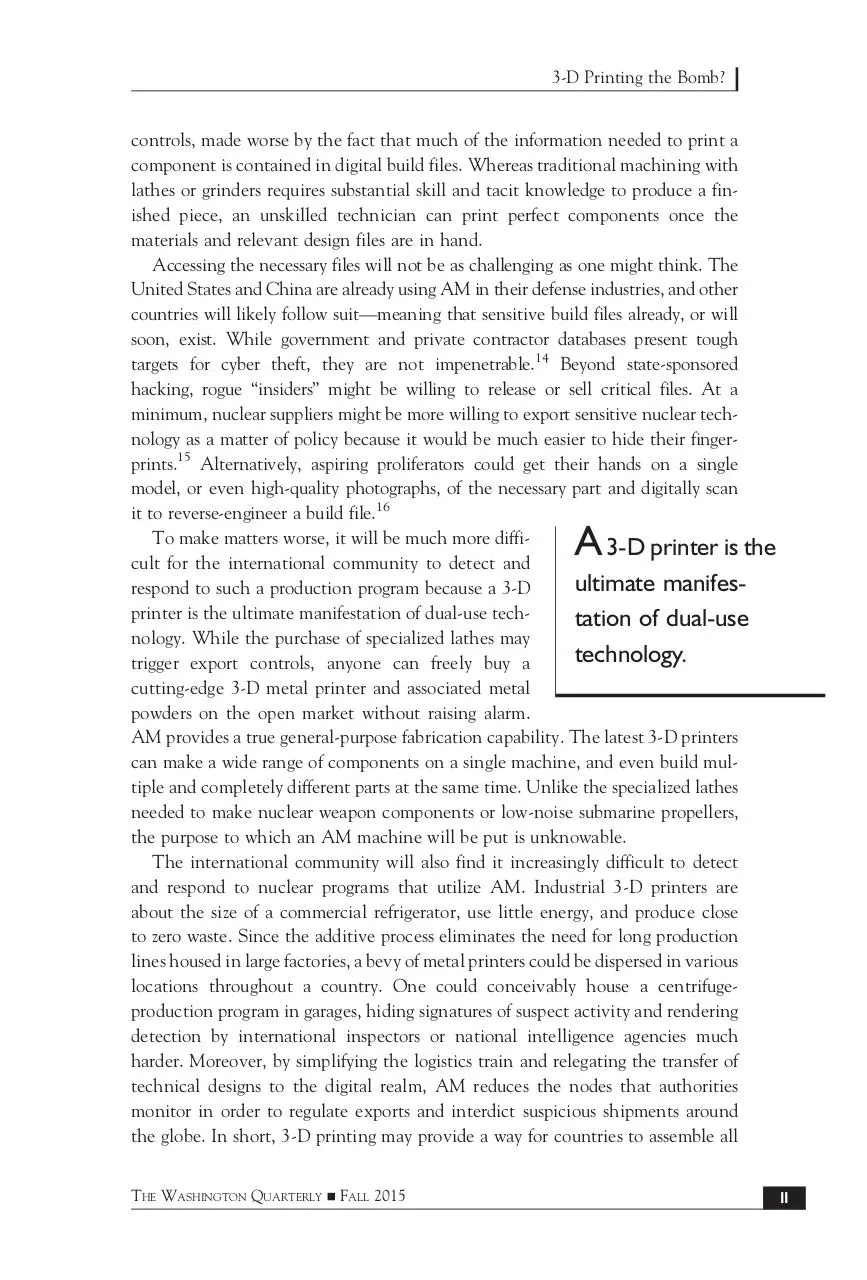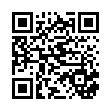TWQ Fall2015 Kroenig Volpe (PDF)
File information
This PDF 1.3 document has been generated by Arbortext Advanced Print Publisher 10.0.1465/W Unicode / Acrobat Distiller 8.1.0 (Windows), and has been sent on pdf-archive.com on 04/04/2016 at 00:08, from IP address 71.202.x.x.
The current document download page has been viewed 542 times.
File size: 111.66 KB (14 pages).
Privacy: public file





File preview
Matthew Kroenig and Tristan Volpe
3-D Printing the Bomb?
The Nuclear
Nonproliferation Challenge
A
revolution in manufacturing is underway that may enable the most
sensitive pieces of a nuclear weapons program to be transferred and produced
around the globe. In the Additive Manufacturing (AM) process, 3-D printing
machines build objects of virtually any shape from digital build files—the essential
data telling printers how to construct an object—by laying down successive layers
of material.1 Since objects are built from scratch, one can make products in shapes
and to standards impossible under any other method, and the digital nature of this
automated process takes most of the skill out of fabrication. AM allows the manufacture of better products, with less effort, and at a fraction of the cost of traditional methods. As a result, it is hardly surprising that General Electric,
Aerojet Rocketdyne, and the Chinese People’s Liberation Army are already
using AM to print sophisticated metal parts for jet engines, rocket propulsion
systems, and fighter aircraft, respectively.2
Like many disruptive technologies, however, AM has a dark side. The widespread adoption of AM will make it easier for countries to acquire nuclear
weapons, and more difficult for the international community to detect and stop
them. If building the bomb is like solving a giant jigsaw puzzle, one of the
hardest parts is simply getting all the necessary pieces.3 Attempts to buy or build
Matthew Kroenig is Associate Professor of Government and Foreign Service at Georgetown
University, a Senior Fellow at the Brent Scowcroft Center on International Security at The
Atlantic Council, and author of Exporting the Bomb: Technology Transfer and the Spread of
Nuclear Weapons (Ithaca: Cornell University Press, 2010). Follow him on Twitter at
@kroenig or email him at matthew.kroenig@georgetown.edu. Tristan Volpe is a Stanton
Nuclear Security Fellow and an associate in the Nuclear Policy Program at the Carnegie Endowment for International Peace. Email him at tvolpe@ceip.org or follow him on Twitter at
@teeandersvolpe.
Copyright © 2015 The Elliott School of International Affairs
The Washington Quarterly • 38:3 pp. 7–19
http://dx.doi.org/10.1080/0163660X.2015.1099022
THE WASHINGTON QUARTERLY ▪ FALL 2015
7
Matthew Kroenig and Tristan Volpe
these items—such as the components of a gas centrifuge—are fraught with
obstacles and set off alarm bells to the existence of a covert weapons program.
In contrast, with a 3-D printer and the right digital build files, a country can
print many of the specialized components for a nuclear program quickly, with
little technical skill, and at low cost. Moreover, hiding such a fabrication effort
would be much easier than under traditional manufacturing methods, rendering
obsolete many of the international community’s tools for spotting illicit nuclear
activity. In short, AM may provide a way for countries to print the pieces of the
nuclear jigsaw indigenously before anyone
notices.
printing will
Fortunately, the proliferation potential of
render obsolete
AM has not yet fully materialized, so the
United States can still lead an international
many of the tools
effort to prevent an AM-enabled cascade of
for spotting illicit
nuclear weapons proliferation before it is too
late. This multifaceted problem demands a
nuclear activity.
strategy that combines the bottom-up efforts
of expert working groups and top-down attention from the highest levels of national governments and international organizations. Together, they can work to create new multilateral frameworks, update
existing control regimes, and develop technical fixes that will allow the world
to reap the benefits of AM while mitigating its proliferation dangers.
3-D
The Allure of Printing Anything, Anywhere, Anytime
Additive Manufacturing (AM) harnesses major innovations in robotics, digital
computing, and the flow of global information over the Internet to give its users
the ability to “make (almost) anything, anywhere,” to use the words of Neil Gershenfeld in a recent article.4 Contemporary 3-D printers create solid items in
almost any form by depositing layer upon layer of metal, ceramic, or plastic
powders. Each strata of material is then welded or melted together using a laser
or electronic beam. This new method of building components from the ground
up stands in contrast to traditional “subtractive” manufacturing. Since the
Stone Age, humans have crafted objects by removing material from a larger
block. The ancient Egyptians developed the first machines to facilitate this
process. The modern metalworking lathe, for example, still follows the same
basic principle employed in antiquity: spin a piece of metal along its axis so the
operator can cut material away from it in a precise and controlled fashion to
create, for example, a symmetrical baseball bat. A 3-D printer, however, frees
engineers from this ancient method, thereby giving them the ability to dream
8
THE WASHINGTON QUARTERLY ▪ FALL 2015
3-D Printing the Bomb?
up novel designs and print unique shapes at standards previously thought to be
impossible.
Another important characteristic of AM is that a digital build file provides
the 3-D printer with all the information it needs to make a final component.
The digital nature of 3-D printing takes much of the skill out of fabricating
precise components. Once the build program is loaded, the printer operates
autonomously on a continuous basis. Subtractive
machine shops require a team of skilled technicians to
he digital nature
operate multiple and highly specialized machines,
of 3-D printing takes
even when automated processes such as computer
numeric control are employed to assist the human
much of the skill out
operators. Furthermore, AM simplifies logistics trains
of fabricating
because there is no need to ship and store parts and
virtually no waste; the end user can just download
precise
the digital file and print the component whenever
components.
and wherever it is needed.
While AM, more commonly known as 3-D printing, has been in the spotlight for its ability to
produce plastic toys, artificial limbs, and even biotechnology, less noticed in the
public sphere is its potential in advanced industrial production, including for
items with sensitive defense and national security applications.5 In March, The
Economist reported that Rolls Royce plans to use AM to construct a critical part
of its Trent XWB-97 jet engine.6 GE followed suit by producing components
for its Leap jet engine, which received Federal Aviation Administration certification.7 Engineers at Airbus leveraged AM to produce titanium structural brackets
for its A350 XWB aircraft.8 Government agencies are also getting into this
game. NASA astronauts onboard the International Space Station used a zerogravity 3-D printer to fabricate a wrench from a digital build file transmitted
from the ground in December 2014. And on the military side, the U.S. Department of Defense highlighted the introduction of AM into the U.S. defense acquisitions and manufacturing process as one way to maintain U.S. strategic
capabilities in a constrained fiscal environment by boutique printing the sort of
special parts needed in weapons platforms, rather than purchasing them in large
batches.9
The AM process is attractive to the aerospace and defense sectors because it
facilitates the production of precision components on demand and around the
world far more cheaply (and often of higher quality) than with subtractive
machines. Indeed, given 3-D printing’s unique ability to cut costs, simplify logistics, and spur innovation, it is hard to overstate its upside potential; AM could
lead to significant reductions in the U.S. defense and nuclear weapons budget,
T
THE WASHINGTON QUARTERLY ▪ FALL 2015
9
Matthew Kroenig and Tristan Volpe
to a revival of U.S. manufacturing, and even to a worldwide manufacturing
revolution.10
While much of AM’s impact will be positive, it also presents a vexing threat to
international security. Machines that can print an infinite range of precise metallic
components from digital files obtained over the Internet are quite appealing to a
country or non-state actor that wants to produce small arms, major conventional
weapons systems, or even nuclear weapons.
The Next Chapter in Nuclear Proliferation
To build nuclear weapons, a state must first produce the fissile material that fuels
the nuclear explosion either by enriching uranium or reprocessing plutonium from
spent reactor fuel and then assembling this nuclear material into a functioning
nuclear device.11 Enrichment and reprocessing are difficult technical feats, made
more complicated by the need to manufacture thousands of metal component
parts to extremely high standards and very close tolerances at each stage, such
as structures to hold the core of a nuclear reactor or the specially-designed rotating
components of a gas centrifuge.12
At present, nuclear suppliers are likely to deny requests for turnkey enrichment
or reprocessing facilities, or their key component parts, due to the proliferation
risks. Stringent international export controls regulate the transfer of related
materials and technology. Transfers of maraging steel or multi-axis computer
numerical controlled lathes, for example, trigger close scrutiny because they can
be used to produce the components in a uranium enrichment centrifuge. Even
if they could acquire samples or designs for component parts, less developed
countries need a long period of time for trial and error to master indigenous production processes. Iran’s nuclear program provides a case in point: the Iranians
took advantage of lax export controls and illicit supply networks to procure
model centrifuges and centrifuge designs in 1987, but it took another fifteen
years before Tehran broke ground on its first enrichment facility.13
Beyond the inherent technical challenges, international monitoring and
response create further obstacles. Export controls slow down proliferators by
forcing them to comb illicit procurement markets in relative secrecy and at
great risk of discovery by the international community. Attempts to buy controlled
items set off alarm bells to the existence of a covert weapons program, thereby
giving the international community time to respond.
Compare this to the realities made possible by AM. At present, an aspiring proliferator can purchase a state-of-the-art 3-D printer on the open market for about
$1 million and the powders that form the raw material of the AM process for only
thousands more. This presents a serious challenge for international technology
10
THE WASHINGTON QUARTERLY ▪ FALL 2015
3-D Printing the Bomb?
controls, made worse by the fact that much of the information needed to print a
component is contained in digital build files. Whereas traditional machining with
lathes or grinders requires substantial skill and tacit knowledge to produce a finished piece, an unskilled technician can print perfect components once the
materials and relevant design files are in hand.
Accessing the necessary files will not be as challenging as one might think. The
United States and China are already using AM in their defense industries, and other
countries will likely follow suit—meaning that sensitive build files already, or will
soon, exist. While government and private contractor databases present tough
targets for cyber theft, they are not impenetrable.14 Beyond state-sponsored
hacking, rogue “insiders” might be willing to release or sell critical files. At a
minimum, nuclear suppliers might be more willing to export sensitive nuclear technology as a matter of policy because it would be much easier to hide their fingerprints.15 Alternatively, aspiring proliferators could get their hands on a single
model, or even high-quality photographs, of the necessary part and digitally scan
it to reverse-engineer a build file.16
To make matters worse, it will be much more diffi3-D printer is the
cult for the international community to detect and
ultimate manifesrespond to such a production program because a 3-D
printer is the ultimate manifestation of dual-use techtation of dual-use
nology. While the purchase of specialized lathes may
technology.
trigger export controls, anyone can freely buy a
cutting-edge 3-D metal printer and associated metal
powders on the open market without raising alarm.
AM provides a true general-purpose fabrication capability. The latest 3-D printers
can make a wide range of components on a single machine, and even build multiple and completely different parts at the same time. Unlike the specialized lathes
needed to make nuclear weapon components or low-noise submarine propellers,
the purpose to which an AM machine will be put is unknowable.
The international community will also find it increasingly difficult to detect
and respond to nuclear programs that utilize AM. Industrial 3-D printers are
about the size of a commercial refrigerator, use little energy, and produce close
to zero waste. Since the additive process eliminates the need for long production
lines housed in large factories, a bevy of metal printers could be dispersed in various
locations throughout a country. One could conceivably house a centrifugeproduction program in garages, hiding signatures of suspect activity and rendering
detection by international inspectors or national intelligence agencies much
harder. Moreover, by simplifying the logistics train and relegating the transfer of
technical designs to the digital realm, AM reduces the nodes that authorities
monitor in order to regulate exports and interdict suspicious shipments around
the globe. In short, 3-D printing may provide a way for countries to assemble all
A
THE WASHINGTON QUARTERLY ▪ FALL 2015
11
Matthew Kroenig and Tristan Volpe
of the necessary components for a nuclear weapons production program while
avoiding detection by the international community.
To be clear, there are limits to what an aspiring proliferator can accomplish
with 3-D printing. AM does not yet offer the promise of printing the bomb
from scratch. Even if a country already possessed significant quantities of highlyenriched uranium or plutonium, no country has, to our knowledge, demonstrated
the ability to feed this fissile material into a 3-D printer to additively manufacture
the core of a nuclear weapon. But we do not want to be caught by surprise
down the road. Moreover, while the ability to print necessary parts in secret
greatly enables a potential proliferator, it does not guarantee success. Would-be
proliferators often run into other supply chain issues when they try to acquire
restricted materials. Even with all the necessary materials and machines in
place, proliferators may struggle to assemble all the pieces into a working fissile
material production capability. The enrichment process in particular presents
technical hurdles beyond production of the necessary parts, such as mastering
the ability to produce UF6—or uranium hexafluoride, a key compound used in
the uranium enrichment process to produce fuel for reactors and weapons—and
then scaling up centrifuge cascades.17 For example, Libya purchased complete
P-1 centrifuges off the black market, but the program struggled to move beyond
testing single machines.18
Moreover, AM may help a state to acquire the components needed for fissile
material production in relative secrecy, but countries can still be unmasked as
they move into the actual operation of facilities using these components. They
can be caught, for instance, in the act of associated tasks of uranium mining,
milling, purification, conversion, and enrichment. Similarly, the construction
and operation of nuclear reactors rarely goes unnoticed. Even if a country prints
everything needed for the front or back end of the nuclear fuel cycle, reactors
or centrifuges will still give off tell-tale signatures, such as effluent waste, which
make them prone to detection.19
In other words, 3-D printers will not make uranium conversion easier, plutonium less toxic to handle, or nuclear reactors any easier to hide. But this new manufacturing technology does promise to facilitate the procurement and production
of necessary component parts that often took countries years to produce on their
own or procure on the black and grey supply markets. AM thereby erodes an initial
and important bulwark to the diffusion of sensitive nuclear fuel cycle technology.20
At present, the international community is concerned that Iran may use its
known nuclear facilities to “break out” and build nuclear weapons. Ever since
Saddam Hussein surprised the world by the extent of his secretive nuclear
buildup in the 1990s, nonproliferation experts have also been concerned about
a so-called “sneak out” scenario, in which a country secretly builds nuclear
weapons using material from undeclared nuclear facilities.21 In the future, the
12
THE WASHINGTON QUARTERLY ▪ FALL 2015
3-D Printing the Bomb?
ability to use 3-D printing technology to surreptitiously manufacture components
may create additional concerns. The ability to stockpile large quantities of centrifuge parts in secret without being detected might turbocharge a covert “surge out”
towards the bomb. A hybrid approach is also possible, whereby a country uses its
secret jump-start to then assemble all the parts in plain view and quickly present a
fait accompli. Indeed, by reducing detection time and making it easier to fabricate
sensitive items, production workshops equipped with AM technology threaten to
enable unprecedented variants of the classic “sneak out” and “break out” proliferation scenarios.
What Can Be Done?
This is not the first time the international community has grappled with the spread
of dual-use technology, but past efforts to control the bomb have largely been reactive. Improvements to the nonproliferation regime almost always spring up in
response to major breakdowns or crises. Fortunately, it is possible to anticipate
the proliferation potential of AM. The United States and its partners should get
out in front of this problem by employing both topdown and bottom-up approaches.
t is possible to
I
anticipate the proliferation potential,
not just respond to a
crisis.
Top-Down: Improve Control Regimes
The United States and other countries have long
attempted to control the spread of sensitive nuclear
technology. In the early 1970s, worries that civilian
nuclear programs might spawn weapons proliferation
motivated representatives from nuclear supplier
nations to meet in Vienna. Under the chairmanship
of Claude Zangger, thus forming the Zangger Committee, these officials discussed
how to better implement export controls mandated by Article III of the Nuclear
Non-proliferation Treaty (NPT). Unfortunately, business interests and politics
among the member states prevented consensus over strict regulations. On May
18th, 1974, India conducted a “peaceful” nuclear explosion, using plutonium
from a Canadian-supplied heavy water power reactor. The next year, then-U.S.
Secretary of State Henry Kissinger convened his counterparts in the other
advanced nuclear countries for a series of meetings in London, which culminated
in the establishment of the Nuclear Suppliers Group (NSG), a cartel of nuclear
suppliers that enacted further restrictions on the availability of sensitive nuclear
technologies.22
When Iraq circumvented these controls by purchasing unregulated items to
build its own sensitive components, the suppliers closed this loophole in 1992
THE WASHINGTON QUARTERLY ▪ FALL 2015
13
Matthew Kroenig and Tristan Volpe
The 2016 Nuclear
by subjecting dual-use technology to enhanced
scrutiny. Over the last few decades, members of
the NSG and the Zangger Committee
Security Summit
expanded the list of items that “trigger” conpresents an ideal
trols and conditional safeguards to keep pace
opportunity to
with advances in nuclear technology, and
established new guidelines to better deal with
address this
the rise of illicit nuclear trade networks.
problem.
While imperfect, this system has proven effective in retarding the global spread of nuclear
weapons, in part because the supplier regimes
continue to evolve, adding new members and reacting to troubling developments
by updating international regulations.23
Like the advent of nuclear technology over seventy years ago, AM represents a
new dual-use technology that presents economic opportunity and security risk.
The current leaders in AM production should take a page out of the nuclear supplier’s playbook and work to set up a new system of multilateral controls and
update existing regimes, most notably the NSG and Zangger Committee but
also the Missile Technology Control Regime (MTCR) and Wassenaar Arrangement, which establishes export controls for conventional arms and other dualuse technologies. Such efforts would allow the world to harness the benefits of
AM while mitigating its downside dangers.
To begin, Washington should immediately convene a high-level meeting with
counterparts in the roughly ten other major AM-producing countries to put the
issue on the international agenda. The upcoming 2016 Nuclear Security
Summit, scheduled to be held in the United States, presents an ideal opportunity
for such a gathering. Fortunately, with the exception of China, all of the companies that produce industrial-grade AM printers are U.S. allies in Europe and Japan.
Emerging producers—South Korea, New Zealand, Singapore, and South Africa—
must also be included. Some technical and policy experts within the U.S. (and
presumably other) governments are already aware of this issue, but the potential
magnitude of the problem demands that it be elevated to the highest government
levels in order to set the stage for a coordinated whole-of-government and, eventually, international approach.24
This new group would work together to develop a set of common-sense standards for controlling the export of metal 3-D printers, sensitive build files, and
specialized metal powders.
One obvious step would be to develop a multilateral system of end-user and
end-use controls, so that the approval of an export license for AM capabilities
depends on the nature of the intended recipient and the proposed activity. Building upon “catch-all” rules used by the multilateral control regimes, these provisions
14
THE WASHINGTON QUARTERLY ▪ FALL 2015
3-D Printing the Bomb?
would prohibit the transfer of 3-D printers or build files to countries or non-state
actors of ongoing proliferation concern, while ensuring the availability of the technology for industrial applications or even for some peaceful nuclear activities
under appropriate safeguards.
Working within existing nuclear trade regimes would be a pragmatic next step
to translate other conclusions from the AM suppliers conference into policy. The
export control regimes already have a formal set of standards to coordinate
actions among members, and AM-related materials and technology should be
controlled much like other sensitive inputs and information. First, technical
working groups should meet to build consensus on possible recommendations.
Next, the United States and its partners could hold special plenary sessions
devoted to updating respective guidelines so that exports of advanced AM printers, sensitive digital build files, and special metallic powders trigger the same
robust scrutiny and requirements for end-user specification as subtractive manufacturing equipment. As a leading member of the NSG, Washington will have
great sway in advancing this agenda from inside—and since the leading developers of AM are located in countries that participate in either the NSG or the
Wassenaar Agreement, action within these institutions could have a significant
impact.
Bottom-Up: Control New Technologies
Beyond updating the export control regimes, the AM
eyond updating
suppliers should also develop an effective system for
export controls,
protecting sensitive build files. States clearly need to
discover unauthorized intrusions into relevant datasuppliers should
bases much more quickly. The Obama White House
also protect sensihas adopted a number of cybersecurity initiatives to
safeguard information in the digital realm and
tive build files.
develop standards with private stakeholders although
recent setbacks, including the OPM data breach,
demonstrate that much work remains to be done.25
Government and industry should explore methods for building safeguards
directly into the build files to make them intrinsically secure. Single-use build
files, programmed to corrupt themselves after completing a specified task, could
ensure proper use by the intended recipient. Designers could disperse information
for the most sensitive items across multiple files on segregated databases to prevent
cyber thieves or insiders from gaining access in one fell swoop. Private industry
may innovate and adopt creative safeguards to protect intellectual property and
share best practices. In the end, devising a solution will ultimately require close
collaboration between national authorities, the cyber community, and commercial
developers of AM technology.
B
THE WASHINGTON QUARTERLY ▪ FALL 2015
15
Download TWQ Fall2015 Kroenig-Volpe
TWQ_Fall2015_Kroenig-Volpe.pdf (PDF, 111.66 KB)
Download PDF
Share this file on social networks
Link to this page
Permanent link
Use the permanent link to the download page to share your document on Facebook, Twitter, LinkedIn, or directly with a contact by e-Mail, Messenger, Whatsapp, Line..
Short link
Use the short link to share your document on Twitter or by text message (SMS)
HTML Code
Copy the following HTML code to share your document on a Website or Blog
QR Code to this page

This file has been shared publicly by a user of PDF Archive.
Document ID: 0000356147.